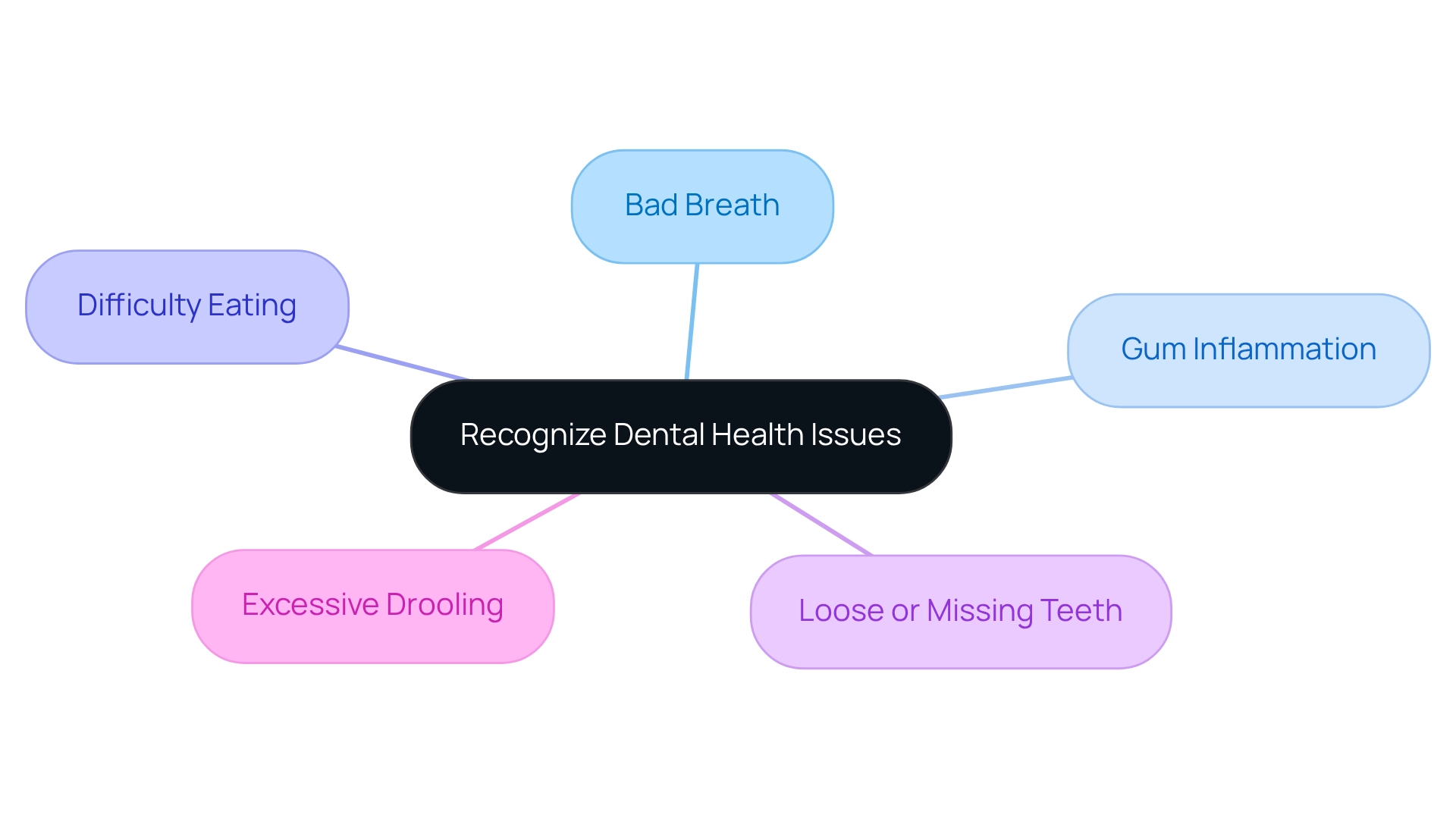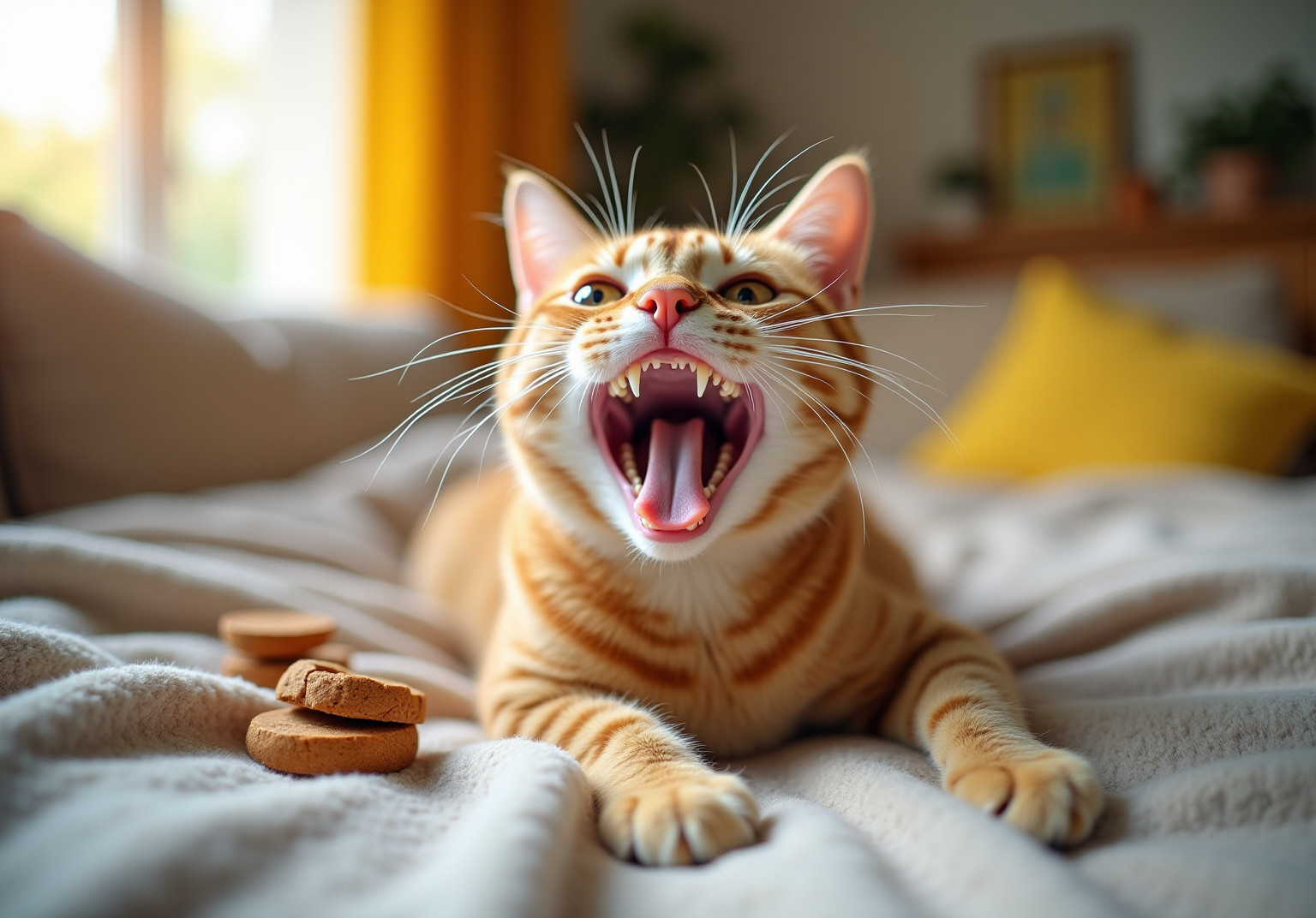How Many Teeth Do Cats Have? Count and Identify Them Easily
Overview
Did you know that your furry family members, cats, have a total of 30 permanent teeth? This includes 12 incisors, 4 canines, 10 premolars, and 4 molars. Understanding this dental anatomy is crucial for ensuring their health and happiness. As a caring pet owner, being aware of their dental structure can help you monitor for potential dental issues.
Imagine the peace of mind you’ll have knowing you can maintain proper oral care routines for your beloved pet. By keeping an eye on their dental health, you can prevent discomfort and promote overall well-being. At Adventure Den, we believe in creating a nurturing environment where your pets can thrive.
Let’s take action together! Regular check-ups and dental care can make a significant difference in your cat’s life. Remember, a healthy smile is a happy smile for your feline friend.
Introduction
In the realm of pet care, dental health is often overlooked, yet it plays a crucial role in your furry family members’ overall well-being. With a unique dental structure comprising 30 permanent teeth, understanding the intricacies of feline dental anatomy is essential for every cat owner. From the sharp incisors that aid in grooming to the powerful canines designed for seizing prey, each type of tooth serves a specific purpose that impacts your cat’s health and lifestyle.
This article delves into the fascinating world of cat dental anatomy, the importance of regular dental care, and how to recognize potential dental health issues. By prioritizing oral hygiene, you can ensure your feline companions lead happier, healthier lives. Remember, a nurturing environment starts with understanding and addressing their needs.
Understand Cat Dental Anatomy
It is interesting to note how many teeth do cats have, as they possess a distinctive oral structure that includes 30 permanent chompers, classified into four varieties: incisors, canines, premolars, and molars. Understanding how many teeth do cats have is essential for recognizing dental health issues in your furry family members. Adult felines possess 12 incisors (6 on the top and 6 on the bottom).
- Canines: Known as fangs, these larger, curved teeth are designed for seizing and holding prey. There are 4 canines in total (2 on the top and 2 on the bottom).
- Premolars: These structures are essential for shearing and grinding food, with cats having 10 premolars (6 on the top and 4 on the bottom).
- Molars: Located at the back of the mouth, molars are specifically used for grinding food. Adult felines possess 4 molars (2 on the top and 2 on the bottom).
The shift to permanent molars in felines is completed by 6 months of age, making it vital for pet owners to observe their pet’s oral development during this crucial time. This anatomical understanding is essential for understanding how many teeth do cats have in order to maintain good oral health. Routine oral hygiene, including brushing and veterinary examinations, is crucial to avert problems like periodontitis, which entails swelling and infection of the ligaments and bone supporting the dentition, resulting in persistent discomfort if left unaddressed. As Ed Malaker, a seasoned author, suggests, ‘Manually brushing your cat’s teeth, offering them a high-quality diet that features dry kibble and oral treats, and attending regular check-ups can help maintain your cat’s teeth in good condition.’ By emphasizing oral care, you can guarantee your feline companions experience a more joyful, robust life.

Identify Types of Cat Teeth
To effectively care for your furry family member’s dental health, it’s essential to recognize the different types of teeth they possess:
- Incisors: These small, sharp structures are primarily used for biting and grooming. They play a crucial role in grasping small objects and food, making them vital for your cat’s daily activities.
- Canines: The prominent fangs are essential for catching and holding prey. Their strength allows cats to tear meat effectively, showcasing their natural predatory instincts.
- Premolars: Designed for shearing food, these structures feature a flat surface that aids in grinding down food before swallowing, ensuring proper digestion.
- Molars: Located at the back of the mouth, molars are responsible for grinding and crushing food, particularly tougher materials like bones, which are important for a balanced diet.
Understanding these types of teeth will help you monitor your cat’s oral health and nutritional needs. It’s important to remember that oral care for felines can be challenging, and neglecting their dental hygiene may lead to systemic illnesses. Regular veterinary check-ups and a balanced diet are essential. As Ed Malaker, a seasoned author, wisely states, “Manually brushing your cat’s chompers, offering them a premium diet that consists of dry kibble and dental treats, and scheduling regular dental examinations can assist in maintaining your cat’s oral health.”
Moreover, while cats do not develop cavities due to the absence of flat grinding surfaces on their molars, they are still susceptible to a condition known as tooth resorption. When considering how many teeth do cats have, it’s notable that kittens develop 26 baby teeth at 2-3 weeks old, transitioning to 30 permanent teeth by around six months. By prioritizing dental care—such as brushing and providing dental treats—you can significantly enhance your cat’s quality of life and prevent severe dental issues. Remember, your love and attention can make all the difference in their health and happiness.
Count Your Cat’s Teeth
To effectively count your furry family member’s teeth, follow these nurturing steps:
- Prepare Your Cat: Create a calm environment for your beloved pet. Having treats nearby can encourage cooperation during the process.
- Gently Open the Mouth: Securely hold your cat and gently lift their lips to reveal their dental structure. If necessary, use your fingers to carefully open their mouth.
- Count the Teeth: Begin at the front and work your way to the back, counting each type of tooth:
- 12 incisors
- 4 canines
- 10 premolars
- 4 molars
- To verify the count, you should confirm how many teeth do cats have, ensuring the total is 30 units. If you notice any missing dental structures or abnormalities, it’s advisable to consult your veterinarian.
Consistently counting your cat’s teeth is essential for tracking their dental condition. Statistics reveal that only around 50% of cats see the vet each year, in contrast to 78% of dogs, emphasizing the necessity for proactive wellness management. As LifeLearn Animal Health states, “This month, take your cat to the vet. She may not express ‘Thank you,’ but her well-being and happiness are gratitude enough!” Furthermore, keep in mind that August 22 is ‘Take Your Cat to the Vet Day,’ a gentle reminder to prioritize your cat’s well-being. To reduce stress during vet visits, leave the carrier out as a comfortable sleeping spot and take your cat on random car rides. By monitoring your cat’s oral condition and ensuring regular veterinary visits, you can help prevent possible medical issues and ensure their overall well-being.
Recognize Dental Health Issues
Being aware of oral health concerns is essential for maintaining your furry family member’s overall well-being. Look for these important signs related to how many teeth do cats have:
- Bad Breath: Persistent bad breath can indicate dental disease, which may cause discomfort for your beloved pet.
- Gum Inflammation: Red, swollen, or bleeding gums are signs of gingivitis or periodontal disease, and they deserve attention.
- Difficulty Eating: If your cat is reluctant to eat or shows signs of pain while chewing, it may be struggling with dental issues that need care.
- Loose or Missing Teeth: Regularly check for how many teeth do cats have, noting any loose or absent teeth during your counts; this can be crucial for their health.
- Excessive Drooling: Increased saliva production can be a sign of oral pain or discomfort, indicating that your cat may need help.
If you notice any of these symptoms, please consult your veterinarian for a thorough dental examination and appropriate treatment. Your pet’s comfort and happiness are worth it.

Conclusion
Understanding the intricacies of cat dental anatomy is vital for every cat owner, as it directly influences your furry family member’s health and happiness. With a total of 30 permanent teeth, each type—from incisors to molars—plays a unique role in grooming, eating, and overall well-being. Regular dental care, including brushing and veterinary check-ups, is essential to prevent serious conditions like periodontal disease and tooth resorption that can lead to chronic pain.
Moreover, recognizing the signs of dental health issues, such as bad breath or gum inflammation, empowers you to take proactive steps in safeguarding your cat’s oral health. Regularly counting and monitoring your cat’s teeth can serve as an early detection method for potential problems, ensuring timely veterinary intervention when necessary.
Ultimately, prioritizing dental health not only enhances the quality of life for your feline companion but also fosters a nurturing environment that reflects your commitment to their well-being. By understanding the importance of dental care, you can help your beloved pet enjoy a longer, healthier life filled with joy and vitality.
Frequently Asked Questions
How many teeth do adult cats have?
Adult cats have a total of 30 permanent teeth.
What are the different types of teeth that cats possess?
Cats have four types of teeth: incisors, canines, premolars, and molars.
How many incisors do cats have?
Cats have 12 incisors, which include 6 on the top and 6 on the bottom.
What is the function of a cat’s canines?
The canines, also known as fangs, are designed for seizing and holding prey. Cats have 4 canines in total, with 2 on the top and 2 on the bottom.
How many premolars do cats have and what is their purpose?
Cats have 10 premolars (6 on the top and 4 on the bottom) that are essential for shearing and grinding food.
What role do molars play in a cat’s dental structure?
Molars are located at the back of the mouth and are specifically used for grinding food. Adult cats have 4 molars (2 on the top and 2 on the bottom).
When do cats complete the shift to permanent molars?
The shift to permanent molars in cats is completed by 6 months of age.
Why is it important for pet owners to understand their cat’s dental anatomy?
Understanding a cat’s dental anatomy is essential for recognizing dental health issues and maintaining good oral health.
What are some recommended practices for maintaining a cat’s dental health?
Recommended practices include routine brushing, offering a high-quality diet with dry kibble and oral treats, and attending regular veterinary check-ups.
What dental issue can arise if a cat’s oral health is not properly maintained?
One potential issue is periodontitis, which involves swelling and infection of the ligaments and bone supporting the teeth, leading to persistent discomfort if left untreated.







